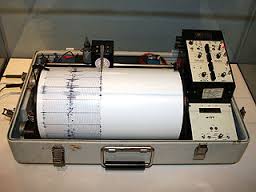How does a seismograph work?« Back to Questions List
|
Scientists who study the earthquakes are called seismologists. One of their important tools is the seismograph which can detect the slightest vibrations in the earth. The movements are recorded by a stylus that traces a line on paper wrapped around a revolving cylinder. When there are no vibrations, the line is straight. Minor tremors cause slight wavers in the line; major jolts produce broad and distinct up and down strokes. Seismograph stations are located all over the world. Seismographs record hundreds of minor tremors every day, but unless their magnitude is above a significant number the jolt is unnoticed by human. This significant number is found out from the ‘ritcher scale’. An American seismologist Charles Ritcher devised a numerical scale for rating the strength of earthquakes. On the scale, earthquake is unnoticed when the magnitude is less than 2. Structural damage is unlikely when the magnitude is less than 5. When the magnitude is 7 or more, it is a severe earthquake. When seismic waves of significant size are registered, comparisons of the intensity of the waves and of the times it took them to reach several stations enable scientists to pinpoint the location and the intensity of earthquakes.
|


